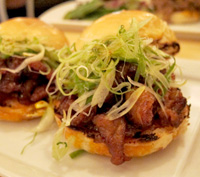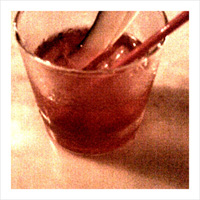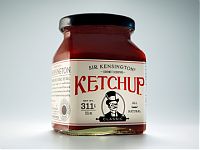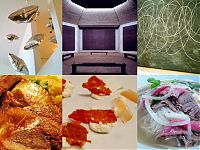Obanzai (daily special side dishes)
by Celia Sin-Tien Cheng
August 24, 2007
HIBINO
333 Henry St
@ Pacific St
Brooklyn, NY 11201
718-260-8052
Hibino is a sweet little Japanese restaurant on the corner of Henry and Pacific Streets in Cobble Hill. They don’t accept reservations, so on a Friday night, my companions and I waited for a good hour before being seated at this bustling, minimalist (it’s truly clean and simple, as opposed to designed to look clean and simple) neighborhood restaurant.
I knew I had to try Hibino when I learned that they serve obanzai ryori (Kyoto home-style daily side dishes). Having lived in Kyoto for a year, I am always nostalgic for the poetic delicacies that come from the ancient Japanese capital (hence Omen being one of my favorite Japanese restaurants in town). The “obanzai” at Hibino, however, is not traditional Kyoto-style but rather the name used to describe the restaurant’s own daily home-style side dishes. Today the specials were pork kakuni (a thick cut of pork belly stewed in a mixture of soy sauce; mirin, a rice-based Japanese cooking wine; sugar and sake), takoyaki (octopus balls), and a nimono (foods simmered in a seasoned broth) of sliced eringi mushrooms (a type of oyster mushroom) with renkon (lotus root). While these are not considered traditional obanzai, all three dishes were excellent and delicately prepared.
The kakuni, served with a dab of Chinese mustard, was the best I’ve tasted in New York. Not only did the fatty part melt in my mouth, but the lean was also tender. My friend, Jennie, is not fond of fat, so we had decided that she would eat the lean, which I often find overcooked, and I would take care of the fat. Of course, that is not the ideal way to eat kakuni. You should have a bit of both because it’s the combination that makes the dish special. We ended up splitting it evenly because, after tasting it, Jennie didn’t mind the fat and I found the lean to be wonderfully juicy and the perfect complement to the fatty part of the pork. Bravo!
You might be familiar with octopus balls as they’re sold at Otafuku on 9th Street across from Sobaya (I don’t recommend them though). The octopus balls at Hibino, however, are the most refined I’ve tasted. A street food popularized in the Kansai (Western) region of Japan, octopus balls are baked batter with pieces of octopus, tenkasu (tempura batter balls), pickled ginger and leeks. The cooked balls are usually dressed with okonomiyaki sauce, mayonnaise, bonito flakes, and aonori (green laver). The takoyaki at Hibino came undressed, which I preferred as all the sauces and spices generally overpower what they are supposed to complement. In addition, rather than being baked in the traditional cast iron griddles lined with holes to make perfectly round balls, these smaller than usual balls were deep-fried like croquettes, so the layer of skin is thicker, and the octopus is in a mashed potato purée inside.
Hibino’s menu is rather varied; in addition to the obanzai specials, the regular menu offers a number of appetizers, entrées and sushi. Another highlight of the evening was the homemade tofu (tofu is a key player in obanzai cuisine), served either hot or cold. We tried the cold, which was adorably served in a miniature glass milk jar with Hibino’s logo. We scooped out individual servings of tofu with little spoons and poured the accompanying soy sauce over it. It was like eating a delicate dessert. The tofu was delicious! Many Japanese restaurants in New York City now make their own tofu, and it’s wonderful to see so many doing it well. This was a real treat. Although next time I think I’ll get a portion just for myself.
I have to give the sushi a mixed review. The regular onigiri sushi was not good, mainly because the fish literally lacked luster. There was no glimmer or sheen on any of the pieces of fish and they tasted dull, too — not as fresh as sushi needs to be. However, Hibino also prepares hakozushi, pressed sushi, the Kansai specialty in which vinegar rice, fish, and other desired ingredients are placed in a rectangular wooden box, pressed with the lid to secure the form, and then cut into pieces. We tried the Kyoto hako sushi — pressed sushi with grilled yellow tail, shiitake and shiso. While I had reservations about ordering cooked yellow tail (a nontraditional hakozushi ingredient, and also like scallops, generally better raw), the flavors all worked and the presentation was beautiful.
For dessert, we shared some green tea azuki (red bean) ice cream, green tea ice cream and the soy milk pudding. The green tea ice cream was a pastel green so light that it almost looked white. I wouldn’t usually care what color the ice cream is, but I do when it tastes as weak and washed out as its hue. The green tea azuki is green tea ice cream with azuki beans — also rather unspectacular. One of my pet peeves is green tea ice cream that doesn’t have the deep, rich taste of real matcha (green tea). It was a good thing we ended the meal with the soy milk pudding, also served in the signature Hibino milk jar. It was actually more like a mousse. The consistency was fluffy, rather than smooth like pudding, but, like the homemade tofu, it was delicious.
I’m excited that there are many interesting, modern Japanese restaurants opening in Brooklyn. Like Zenkichi of Williamsburg, though, I wish Hibino were in my neighborhood — Greenwich Village. But then again, if not in Cobble Hill, Hibino probably wouldn’t be as laid back, hip and charming. For local Brooklynites, Hibino is a good destination for Japanese comfort food. If I lived in the neighborhood, I’d probably visit at least once a week for their delectable specials.
Also in Cobble Hill, Japanese


















